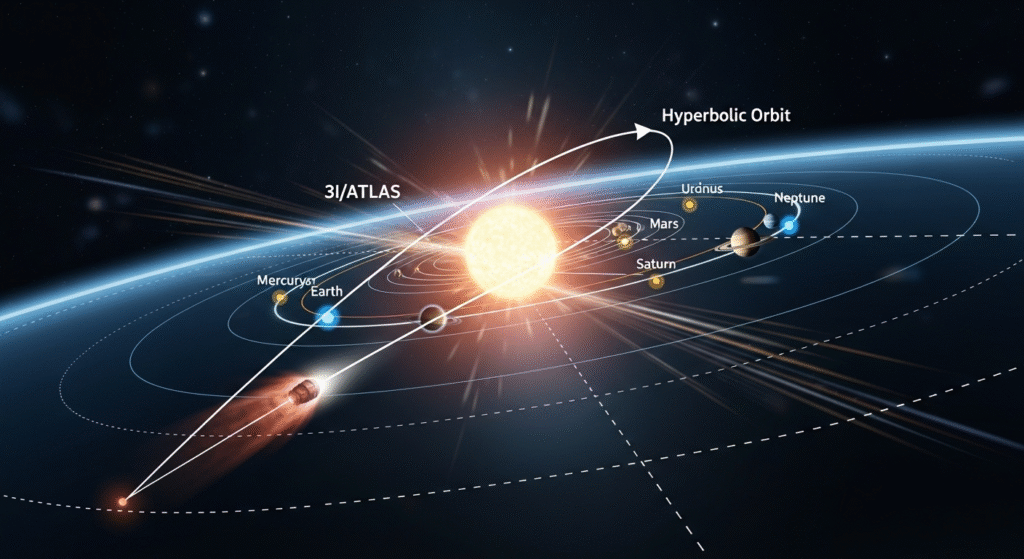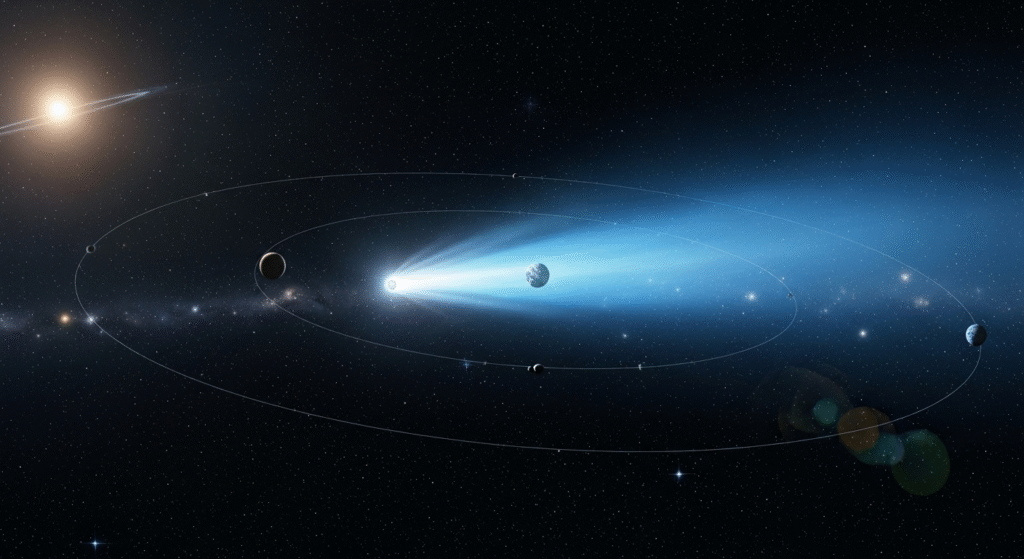The interstellar object 3I/ATLAS has captured the attention of astronomers and space enthusiasts across the globe. Discovered on July 1, 2025, by scientists using the ATLAS telescope in Río
Hurtado, Chile, this faint and fast-moving body is unlike anything ever observed. It marks the third confirmed interstellar object to enter our Solar System — following ʻOumuamua in 2017
and 2I/Borisov in 2019.

What is the interstellar object 3I/ATLAS?
The interstellar object 3I/ATLAS is believed to be a comet, showing typical features such as a bright tail and the release of gas and dust as it approaches the Sun. Its name comes from its origin: “3” for the third interstellar object ever found, “I” for interstellar, and “ATLAS” for the telescope network (Asteroid Terrestrial-impact Last Alert System) that discovered it.
What makes the interstellar object 3I/ATLAS truly fascinating is its origin. Its velocity and trajectory indicate that it is not gravitationally bound to the Sun, meaning it came from another star system and happened to pass through ours purely by chance.
How fast is the interstellar object 3I/ATLAS traveling?
According to astronomers, the interstellar object 3I/ATLAS is racing through space at more than 200,000 km/h (about 61 km per second), accelerating as it nears the Sun. Its path is hyperbolic, which means it’s moving too fast to be captured by the Sun’s gravity.
Con Stoitsis, Director of Comets and Meteors at the Astronomical Society of Victoria, explained that it will pass through the inner Solar System — between the orbits of Mars and Earth — before swinging around the Sun and heading back into deep space.
NASA estimates that the closest the interstellar object 3I/ATLAS will get to Earth is about 270 million kilometers, which is far enough to be safe but close enough for observation with modern telescopes.
Could 3I/ATLAS be something more than a natural object?
While most scientists agree that the interstellar object 3I/ATLAS is a natural comet, not everyone is convinced. Theoretical astrophysicist Avi Loeb from Harvard University has urged researchers to keep an open mind about its true nature.
Through the Galileo Project, which investigates potential signs of extraterrestrial technology, Loeb has suggested that the interstellar object 3I/ATLAS might even be an artificial probe created by another civilization.
In a series of essays published on Medium, he questioned whether the object’s glow could come from its own light rather than reflected sunlight — a feature never seen in any known comet.
“The hypothesis is that the recent interstellar visitor to our Solar System, 3I/ATLAS, might be a technological artifact — possibly with active intelligence,” Loeb wrote.
“If that’s true, the implications for humanity could be profound.”
NASA scientists, however, have firmly rejected this idea. Tom Statler, NASA’s lead scientist for small Solar System bodies, stated: “It looks like a comet. It behaves like a comet. In nearly every way, it is consistent with comets we already know.”
Loeb later clarified that his goal was not to make definitive claims but to encourage scientific curiosity. “Let’s keep our childlike wonder,” he wrote, “and seek evidence rather than pretending to have all the answers.”
When will we be able to see the interstellar object 3I/ATLAS?
The interstellar object 3I/ATLAS will make its closest approach to the Sun around October 30, 2025, reaching about 1.4 astronomical units (au) — roughly 130 million miles — inside Mars’s orbit.
According to NASA, it may become visible again from Earth in early December 2025, once it moves out from behind the Sun. Depending on its brightness, amateur astronomers using mid-sized telescopes may be able to spot it against the night sky.
What can 3I/ATLAS teach us about the cosmos?
Each encounter with an interstellar object gives scientists a rare glimpse into other star systems. By studying the interstellar object 3I/ATLAS, researchers hope to learn more about how planetary systems form and evolve — and perhaps even uncover clues about the conditions that allow life to exist elsewhere in the universe.
These cosmic visitors act as messengers from distant regions of the galaxy, carrying valuable information about chemical composition and space dynamics that can broaden our understanding of the universe’s origins.
The connection to other space discoveries
The excitement surrounding the interstellar object 3I/ATLAS comes at a time of extraordinary space discoveries. Recently, the James Webb Space Telescope detected “seeds of life” on a frozen star beyond our galaxy — a breakthrough that expands our knowledge of cosmic chemistry.
You can read more about that discovery in this Euronews report.
Together, these findings highlight how the universe continues to surprise and inspire us, pushing humanity to keep exploring and questioning what lies beyond.

The legacy of the interstellar object 3I/ATLAS
Regardless of whether it’s merely a comet or something far more mysterious, the interstellar object 3I/ATLAS has already earned its place in modern astronomy. It reminds us of the vastness of space and the importance of curiosity — the driving force that keeps us searching the stars for answers and, perhaps one day, for company.
Related Articles
